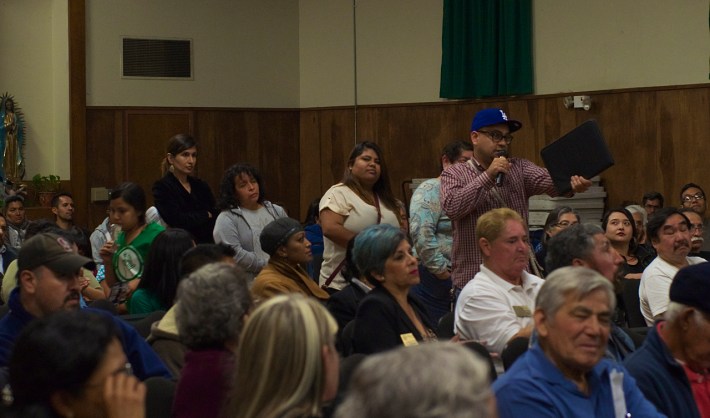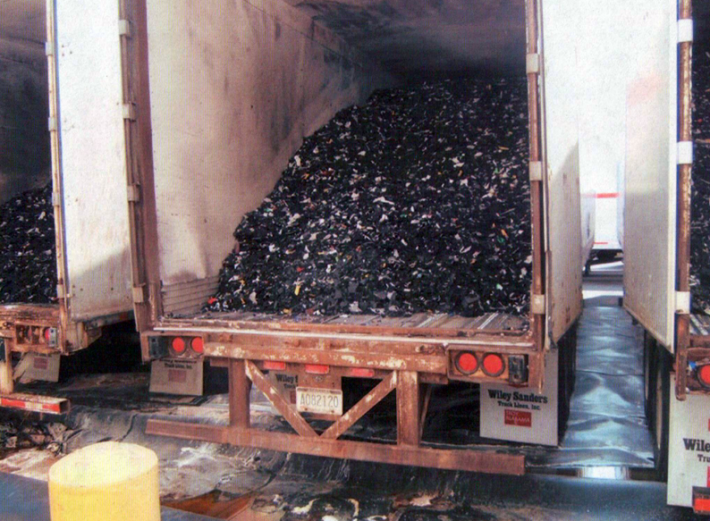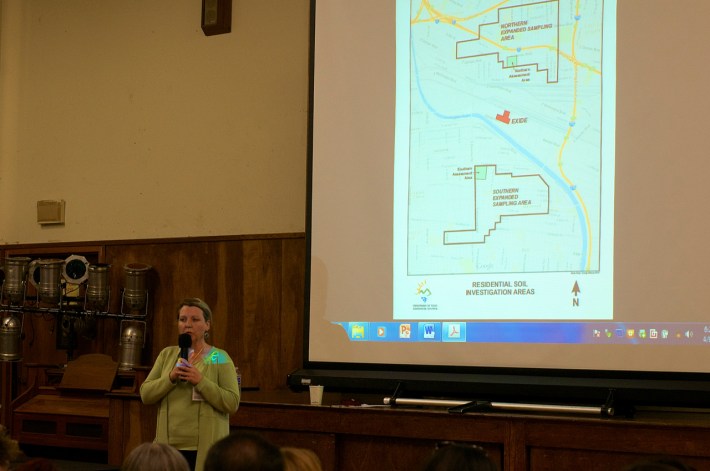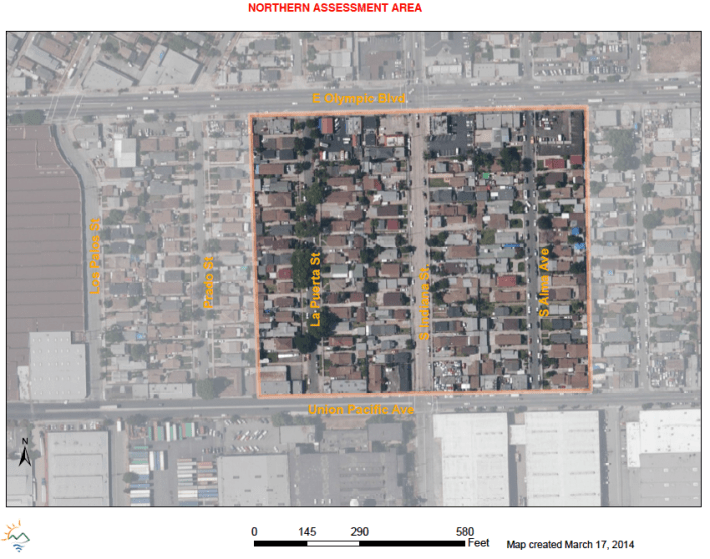
"We won, folks. We won!" Monsignor John Moretta addressed the crowd that had gathered at Resurrection Church in Boyle Heights to hear about the process by which the closure of Exide Technologies' embattled lead-acid battery recycling facility would begin. "Siempre adelante. Siempre adelante." [Always moving forward.]
To a degree, the conversation that took place last Thursday regarding the closure of the Vernon plant did genuinely feel like a step forward. A small one, to be sure, but a step forward nonetheless.
For one, Department of Toxic Substances Control (DTSC) Director Barbara Lee was on hand to speak with the community. That alone was unusual, in that, in the many years the community has spent demanding their health be protected, the director of the department had never made such a clear effort to engage stakeholders both formally and informally.* But so was the level of candor with which she addressed those in the audience.
"Many of you are very angry and many of you have been harmed in a number of ways. And you feel that the department has failed you," she began. "I want to start by saying I'm very sorry."
Then, in a solemn sotto voce, she ticked off a long list of ways in which the department had gotten it wrong.
"[Exide] should not have operated without a formal permit for decades...We should have acted sooner;" "We didn't watch them the way we should have done over many years;" "We failed to see and failed to say when enough was enough;" and, "We haven't worked well with co-regulators...for many years."
She was referring to the impressive level of negligence on the part of the DTSC and other relevant authorities that allowed Exide (and its predecessors) to operate without a formal permit and largely with impunity for decades. As we recently charted here, Exide has repeatedly violated air quality and other standards by improperly storing lead-acid batteries, contaminating a drainage channel with lead, failing to clean up public areas it contaminated around the plant, spilling approximately 1136 lbs. of lead into the watershed (between 2003 and 2006), exceeding airborne lead emissions multiple times (including during the period it was closed for upgrades last year), not repairing degraded pipes carrying up to 310,000 gallons of contaminant-laden wastewater a day, and, most recently, storing “contaminated sludge in tanks that [it] is not authorized to operate,” failing to sufficiently protect against spills of hazardous waste, and “fail[ing] to minimize the possibility of any unplanned sudden or non-sudden release of hazardous wastes or hazardous waste constituents to air, soil, or surface water.” (For the full slate of inspection reports and a thorough overview of Exide's misdeeds, see Tony Barboza's excellent report for the L.A. Times, here.)
"We didn't listen to you," Lee concluded, "but I am here to listen to you today."
Instead of asking attendees to take her word for it, she ran down a list of the changes she had made to the way the DTSC operated since she had taken over the department last November. She had committed to the recommendations resulting from an audit of the department's permitting process, which included the need for a speedier review process and the clearing out of backlogged applications. She appointed new division chiefs to the Enforcement and Permitting offices, as well as a new deputy director for Enforcement. And she put together a 45-person team to work on the Exide case, had inspectors on site every day, and would both be adjusting the standards by which they judged future operating permit applications and consulting with communities as part of that process.
With regard to current goings-on at the Vernon plant -- where between 6 and 8 truckloads of hazardous waste are being packed up and shipped out to a facility in Muncie, Indiana, per day -- Lee said Exide was tasked with ensuring that waste was fully wrapped and sealed (so it couldn't leak from trucks, as it had in the past, below), trucks were washed before they left the site, and trucks were not idling in or moving through residential communities during the 60 days Exide estimated it would take to remove the waste 2000+ miles away (see Exide's plan, here).

When it came time for the plant itself to be dismantled, Lee said, the structures would likely be both power washed and wrapped so they were wet, covered, and less likely to send toxic dust into the air when taken down.
Although the DTSC was still waiting for Exide to complete and submit its final plans for the closure and post-closure clean ups -- it must do so by May 15 -- Lee reiterated she would hold both Exide and the DTSC to high standards to protect the community. And the lessons learned from this case would be applied to other cases going forward.
The 200 or so attendees on hand seemed to take her at her word. Many that got up to speak thanked her for her sincerity and what appeared to be her genuine interest in engaging with community members.
But it didn't mean all was forgiven.

"We haven't won anything yet!" said one gentleman, irked by both past negligence and the pace and scope of the testing and clean-up of lead contamination at the homes in the two assessment areas (identified by the AQMD as the areas most likely to have been affected by lead emissions, see above and below).
The testing and clean-up of the 217 properties contained within the Northern and Southern Assessment Areas has been underway for over a year now. Per an order, Exide must clean up any home where lead levels exceed 400 parts per million, as well as any home with bare soil where levels exceed 80 parts per million (the level at which the state recommends further health screenings).

To date, 59 properties have been cleaned up, 96 are awaiting clean-up, 3 are awaiting their test results, and 3 required no action to be taken.

While it is truly troubling that nearly all of the tested properties will require cleaning up, area residents find the fact that as many as 56 properties remain untested to be of even deeper concern.
Given the high level of rentership in the communities where the assessment areas fall, the actual tenants of contaminated and potentially-contaminated homes are left out of the decision-making about testing and clean-ups. Worse still, according to some of the meeting attendees, the tenants are not always informed of what was found at the homes they inhabit. Those living on properties where landlords have neglected or refused to respond to the DTSC fear they have little recourse to ensure any existing lead contamination is removed.
Residents were also concerned that homes outside the assessment areas would have to wait years for testing and clean-up, and that there would be no compensation for any of the residents any issues in their homes or with their health that might be attributed to Exide's lead and arsenic emissions.

Lee reassured residents that testing in an expanded area was already underway and that they would do what was necessary to ensure clean-ups were completed as quickly and as thoroughly as possible. The results of the testing, she said, would be available at the next community meeting, currently scheduled for May 6. As for reluctant landlords, she said, she would try, via correspondence, to let them know what their liability would be should there be lead contamination on the property.
With regard to the question of compensation for residents, however, the news was not good. Under Exide's recent bankruptcy settlement, Lee said, there were no monies that could go to affected community members or be invested in health clinics, job centers, or any other community-centric endeavors.
And real justice would continue to remain elusive.
Thanks to the non-prosecution agreement Exide reached with the Department of Justice last month, despite having essentially copped to committing four felonies a day for over a decade, Exide was off limits for prosecution. Criminal penalties could be imposed, should Exide fail to comply with the terms of its agreement with the DOJ. But such a scenario is years off, at best, given the ten-year window to comply with the agreement.
The community's anger over their inability to hold a known violator accountable was palpable. But Mark Lopez, Director of East Yard Communities for Environmental Justice (EYCEJ), was not willing to drop the subject. Exide may have been the one to do the damage, but it was only because others made it easy for them to do so.
"At what point could this have been stopped?" Lopez asked. "We want to know what happened."
Whatever had happened, he argued, merited an independent criminal investigation. "We're not just going to move on. This is part of our community story. I'd like justice to be part of this story."
When Lee acknowledged she had found instances of negligence -- moments when people didn't act fast enough or didn't hold Exide to DTSC's standards -- but not outright criminal activity, despite having "looked pretty hard" for it, Lopez pushed back.
"We want accountability..." he said. "Where are those people that made bad decisions? Are they making bad decisions somewhere else? What happened in the past is not your fault but, moving forward, it's your responsibility."

While she asked for time to consider that option, another gentleman raised concerns about the DTSC's potential to protect others from toxic waste. "Where is the waste going?" he asked. "We don't want to contaminate other communities."
He was right to be concerned. It does appear that the problem is being pushed from one marginalized community to another. The destination for the Vernon waste -- Exide's Muncie, Indiana, facility -- was the subject of a federal lawsuit settled just one month ago. For violating the Clean Air Act and exceeding lead emissions standards, the $3.9 million settlement requires Exide to install state-of-the-art pollution control equipment and pay out over $800,000 in additional civil penalties.
That settlement is the latest of grievances against the facility there. In 2007, Exide paid out $115,400 for emissions violations and $62,500 for hazardous waste violations. Just two years later, it paid out nearly $100,000 in civil penalties for excessive lead emissions. And while the fact that fines were levied at all may seem to indicate that Indiana is more on top of things than California, it apparently didn't stop Exide from letting other things slide, such as "its contingency plan for emergencies like fire, explosions, and spills; cracks and gaps in a containment building that could lead to a fire or explosion; improper storage of furnace slag beyond a boundary; and brown-colored, lead-contaminated water along a storage area and rail spur as well as dead vegetation near a ditch leading to a storm drain."
Concerns about other communities aside, it isn't clear that we have a full accounting of the damage Exide has done here, yet. When a man stating he had "too many complaints" about Exide asked about the contamination of the river, Leonard Grossberg, Director of the Health and Environmental Control Department in Vernon, enthusiastically noted that the City of Vernon had been testing the water around the plant for some time and had published a report with their findings.
Grossberg was decidedly less open about what those findings were. Only after being booed for suggesting residents do a public records request did he acknowledge the water had indeed been contaminated and say he'd try to get the report to Barbara Lee.
His reluctance to share what should have been public information with the very people that needed it most epitomized the run-around the community believes public officials have given them for years.
Roberto Cabrales of Communities for a Better Environment (CBE) reminded the politicians and staff that had come to celebrate the victory that they had been nowhere to be found when CBE, EYCEJ, and others were seeking support in the fight to close the plant.
Terry Cano cried as she spoke of the illnesses that had ravaged the members of her family that lived near the plant. Those that had left the area, she said, were healthy. But those that had stayed were dying.
"I can barely breathe or move, and you're telling me this is the best you can do?"
An elderly woman, hands and voice shaking, thanked the officials for coming and listening, but suggested listening was not enough. To understand what it was like to live in a community whose environment had been so badly abused, they needed to see it for themselves.
"Me falta el aire y tengo mucha tembladera. Estoy muy mal." (I cannot breathe and I am shaking a lot. I am not well.), she said quietly. "Dale una vueltecita para allá para ver los enfermos que hay por aquí." (Take a walk around the neighborhood to get a sense of how many are sick here.)
A representative from the Department of Public Health reassured her that they did indeed care about the health of the community and that they would have staff at the May 6th meeting who could help determine if residents' health issues could be linked to particular emissions and get them plugged into the services they needed.
It was, as noted earlier, a good start. But the community's troubles are far from over. As County Supervisor Hilda Solis declared to attendees, "This is an EJ [environmental justice] community. We know that."
Exide may be on its way out, but other polluters remain.
"I'd love to see more tracking of [toxic] hotspots..." she said. "I think we can do more to get our communities serviced."
* * * *
*This story has been updated at 12:28 p.m. to correct the claim that a past director from DTSC had not met with the community. Former Director Debbie Raphael did speak at a town hall in 2013.
A follow-up meeting to report on the findings of the soil sampling for lead contamination in the assessment area as well as the extended assessment area will be held May 6; details forthcoming. For more information about the DTSC's oversight of Exide's progress, see their dedicated page, here. For updates on the AQMD's monitoring of compliance, please visit their page, here.






